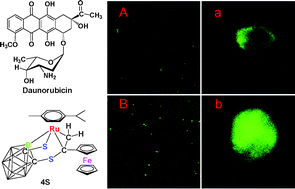Addition of ethynylferrocene to transition-metal complexes containing a chelating 1,2-dicarba-closo-dodecaborane-1,2-dichalcogenolate ligand—in vitro cooperativity of a ruthenium compound on cellular uptake of an anticancer drug†
Abstract
The addition reactions of the 16e half-sandwich complexes (p-cymene)M(S2C2B10H10) (1S, M = Ru; 2S, M = Os) and Cp*Ir(E2C2B10H10) (3S, E = S; 3Se, E = Se) with ethynylferrocene lead selectively to the 18e complexes (p-cymene)Ru(S2C2B10H9)(H2CCFc) (Fc = ferrocenyl) (4S), (p-cymene)Os(S2C2B10H9)(H2CCFc) (5S), Cp*Ir(S2C2B10H9)(H2CCFc) (6S) and Cp*Ir(Se2C2B10H9)(H2CCFc) (6Se), in which the


 Please wait while we load your content...
Please wait while we load your content...